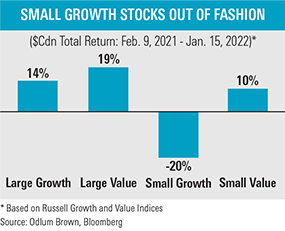
Looking back, 2021 was a great year for the economy and many stocks. After contracting in 2020, the global economy expanded by an estimated 5.6% last year, while the MSCI World Index produced a total return, including dividends, of 21.2%1.The main Canadian and U.S. equity benchmarks led the world’s major markets with returns of 25.3% and 27.5%, respectively.
While the overall global economy is back on its pre-pandemic expansion track, many markets are still struggling. In particular, stocks in developing countries have lagged, with the MSCI Emerging Markets Index producing a loss of 3.4% in 2021. The Organisation for Economic Co-operation and Development (OECD) believes that lower-income economies, particularly those where vaccination rates are low, are at risk of being left behind.
The OECD predicts that global growth will moderate to 4.5% in 2022 and 3.2% in 2023, and cites inflation as the greatest risk to the economic outlook. If elevated inflationary pressures prove to be persistent, central banks might have to raise interest rates sooner and by more than expected.
The prospect of slower economic growth and higher interest rates has made investors nervous. Consequently, equity market volatility has recently intensified. While the major stock market averages are holding fairly close to their highs, there have been notable shifts in which stocks are leading and considerable drawdowns in parts of the market.
 Many of the popular stocks in the first half of the pandemic have fallen hard, while those that initially lagged have recently performed remarkably well. Growth stocks in general, and small growth stocks in particular, were the early winners, but it’s the smaller growth stocks that have fallen the hardest. In fact, since peaking in the second week of February 2021, a little less than a year ago, and through to January 15, 2022, the Russell 2000 Growth Index of smaller stocks is down about 20%. Since that time, large growth stocks are up roughly 14%, while large and small value stocks are up 19% and 10%, respectively.
Many of the popular stocks in the first half of the pandemic have fallen hard, while those that initially lagged have recently performed remarkably well. Growth stocks in general, and small growth stocks in particular, were the early winners, but it’s the smaller growth stocks that have fallen the hardest. In fact, since peaking in the second week of February 2021, a little less than a year ago, and through to January 15, 2022, the Russell 2000 Growth Index of smaller stocks is down about 20%. Since that time, large growth stocks are up roughly 14%, while large and small value stocks are up 19% and 10%, respectively.
Let’s look at one exchange-traded fund (ETF) that is illustrative of this trend. Cathie Wood, CEO of ARK Invest, was the star investment manager in 2020, but her success peaked around the same time that small growth stocks were hitting their highs. Since its peak in February 2021, Wood’s ARK Innovation ETF is down about 50%, paralleling the decline in the Goldman Sachs Non-Profitable Tech Index. While the businesses in the fund have exciting long-term prospects, many have yet to earn a profit. Large holdings in the fund, such as Teladoc Health, Zoom Video Communications, Roku Inc., Spotify Technology, Block Inc. (formerly Square Inc.) and Shopify have suffered major declines.
What’s noteworthy is that since the pre-pandemic market peak on February 20, 2020, and through to mid-January 2022, the ARK ETF has underperformed the broad U.S. market and some big value names. Over the near 23-month period, the ARK ETF returned 30% versus 35% for the S&P 500 Index, 35% for Warren Buffett’s Berkshire Hathaway and 47% for The Royal Bank of Canada.
Why are small growth and non-profitable tech stocks performing so poorly relative to other stocks? We believe it is because they were overhyped and overpriced. These stocks were major beneficiaries of the massive fiscal and monetary support provided by the authorities. Now that fiscal programs are abating and central banks are tapering their bond-buying programs and preparing to raise interest rates, the hot, hyper-growth stocks are losing their appeal and support. Market liquidity is still ample, but the general expectation is that it will deteriorate as the year progresses. The market is forward looking, and stock valuations are starting to matter more to investors as they look ahead to a time when financial conditions and liquidity won’t be as favourable.
We think 2022 will be a tougher year for the economy and for stocks. As such, we believe investors should moderate their return expectations and be prepared for increased market volatility.
Many pundits are arguing that value-type stocks, like banks and energy firms, will continue to perform better than growth-oriented stocks, like Google and Microsoft. Their view is underpinned by the mathematical reality that higher interest rates weigh more heavily on the valuations of businesses that produce greater earnings further into the future. Yet, it’s also true that growth stocks tend to outshine value stocks when economic growth slows, as investors are usually inclined to pay a bigger premium for the narrower group of businesses that can deliver growth in a slower-growth world.
In general, we expect large-cap stocks – the big and familiar companies that dominate our clients’ portfolios – to do better than small-cap stocks in 2022. This is typically the case when investors start to get nervous late in an investment cycle. Because central banks are expected to raise interest rates to fight inflation and since growth stocks are considerably pricier than their value counterparts, it’s tempting to favour value stocks over growth. While that is a logical conclusion, we think it is too broad a generalization. The correct posture will likely prove to be more nuanced, in our opinion.
We think quality will override growth and value as the most important factor this year, and we believe both growth and value stocks with strong fundamentals will perform well in an environment with slower economic growth and tighter monetary policy. Larger, higher-quality growth businesses with deep economic moats and reasonable valuations should be favoured over more speculative, higher-growth businesses. Accordingly, we favour the FAANGM group of businesses (Facebook, Apple, Amazon, Netflix, Google and Microsoft) and other large growth stocks like Visa and Starbucks over the speculative, higher-growth businesses promoted by Ms. Wood and featured in the ARK ETF.
With many of the former market darlings down considerably from their highs, some investors see bargains and opportunity. While there are certain to be proverbial “babies thrown out with the bathwater,” we caution against the idea of using discounts to peak values as a barometer. Peak valuations achieved during a liquidity-driven speculative craze are seldom good yardsticks to measure value. In many cases, the prices of the former darlings are still higher than their pre-pandemic levels and rich relative to their underlying fundamentals. If the fall-out from the dot-com bubble is a guide, it could be a long time before speculative growth stocks shine again.
Higher-quality value firms – both large and small – with solid and enduring business models and strong balance sheets should be favoured over lower-quality value businesses. Canadian Banks, Utilities, Telcos, Consumer Staples and Health Care are among the value-oriented industries that we think will outperform in 2022. While we are generally less enthusiastic about economically sensitive businesses, we remain constructive on Energy firms, as oil and gas prices will likely be supported by the lack of investment in the sector in recent years.
Above all else, we believe it’s important to be diversified. While our top-down views on the economic outlook have some influence on our bottom-up, company-by-company analysis and recommendations, it’s important to appreciate that economic forecasts can be wrong. Consequently, it’s most important to focus on where businesses will be three to five years down the road and make sure portfolios hold a diverse collection of high-quality businesses that will endure and thrive in the long run.
1 All return figures in this article are in Canadian dollars and include reinvested dividends.
Please read our Odlum Brown Limited Disclaimer and Disclosure - It is important!
Odlum Brown Limited is an independent, full-service investment firm focused on providing professional investment advice and objective research. We respect your right to be informed of relationships with the issuers or strategies referred to in this report which might reasonably be expected to indicate potential conflicts of interest with respect to the securities or any investment strategies discussed or recommended in this report. We do not act as a market maker in any securities and do not provide investment banking or advisory services to, or hold positions in, the issuers covered by our research. Analysts and their associates may, from time to time, hold securities of issuers discussed or recommended in this report because they personally have the conviction to follow their own research, but we have implemented internal policies that impose restrictions on when and how an Analyst may buy or sell securities they cover and any such interest will be disclosed in our report in accordance with regulatory policy. Our Analysts receive no direct compensation based on revenue from investment banking services. We describe our research policies in greater detail, including a description of our rating system and how we disseminate our research here.
This report has been prepared by Odlum Brown Limited and is intended only for persons resident and located in all the provinces and territories of Canada, where Odlum Brown Limited's services and products may lawfully be offered for sale, and therein only to clients of Odlum Brown Limited. This report is not intended for distribution to, or use by, any person or entity in any jurisdiction or country including the United States, where such distribution or use would be contrary to law or regulation or which would subject Odlum Brown Limited to any registration requirement within such jurisdiction or country. As no regard has been made as to the specific investment objectives, financial situation, and other particular circumstances of any person who may receive this report, clients should seek the advice of a registered investment advisor and other professional advisors, as applicable, regarding the appropriateness of investing in any securities or any investment strategies discussed or recommended in this report.
This report is for information purposes only and is neither a solicitation for the purchase of securities nor an offer of securities. The information contained in this report has been compiled from sources we believe to be reliable, however, we make no guarantee, representation or warranty, expressed or implied, as to such information's accuracy or completeness. All opinions and estimates contained in this report, whether or not our own, are based on assumptions we believe to be reasonable as of the date of the report and are subject to change without notice.
Please note that, as at the date of this report, the Research Analyst responsible for the recommendations herein, associates of such Analyst and/or other individuals directly involved in the preparation of this report hold securities of some of the issuer(s) referred to directly or through derivatives.
No part of this publication may be reproduced without the express written consent of Odlum Brown Limited. Odlum Brown Limited is a Member-Canadian Investor Protection Fund.